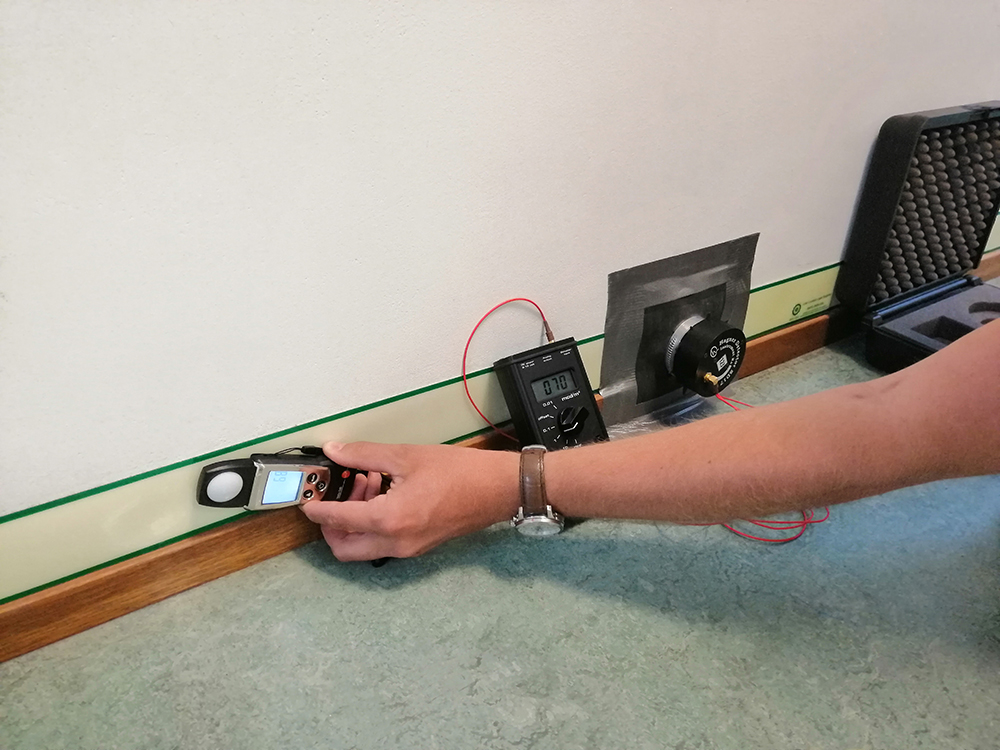Testing & Measurements
Testing & measurements – According to ISO 15370:2010 and IMO Resolution A.752 (18), all Low Location Lighting systems should have their luminance tested at least once every five (5) years. Essentially, the goal of a test/measurement of the Low Location Lighting system is to make sure that the system still has enough light output to ensure its effectiveness.
Why are low location lighting measurements necessary?
Multiple regulations require vessels that carry passengers to have a Low Location Lighting system installed. This could be a photo luminescent system as well as an electric system. A photoluminescent system is charged by the lighting on the vessel and will use the energy it collects to light up in the dark. The big advantage of this system is that there are no electric installations that need to be installed. This will save you money in installation costs, as well as the costs of running the system.
Electrical low location lighting systems are connected to the electric network of the ship, and will switch on when the regular lighting of the ship shuts off.
In summary; photoluminescent systems require daylight and / or artificial light to run and do not need electric power. Electrical systems do not require daylight or artificial light to run, but require a controlling and electrical system to operate.
The regulations that require having a Low Location Lighting system also state that the installed Low Location Lighting system should be checked and measured once every five years. This periodic measurement must meet the DNVGL regulations. In order to make sure that the luminance measurements are done by a neutral, impartial surveyor, regulations won’t allow vessel owners to do the measurements themselves. This is where we can help you by performing these certified measurements.

How does a low location lighting measurement work?
The goal of the Low Location Lighting measurement is to make sure the system still has enough light output to ensure its effectiveness. If not, the system’s performance is insufficient and won’t meet the expected standards set by the regulations. We measure the minimal light / luminance output the system should meet in “Lumen”.
We approve our engineers according to DNVGL (view our DNV GL certificate here) and use high-end equipment that measures the mentioned light output. Logically, measuring an electric LLL system differs from measuring a photo luminescent system. This due to the fact that electric systems don’t require any light to charge up the system, and can be measured instantly. On the other hand, electric systems must be able to run on battery power for at least 60 minutes. To ensure a representative measurement, you need to charge photoluminescent systems properly, which our specialized engineers will take into account.
What if the results of the low location lighting measurements are negative?
If the luminance for a particular reading does not meet the requirements of the guidelines, readings should be taken in at least ten locations equally spaced apart in the space. If more than 30% of the readings do not meet the requirements of the guidelines, the entire Low Location Lighting system should be replaced.
We are specialists in the field of installation and renewal of Low Location Lighting systems. Contact us today if you would like to receive a quote for the certified installation of a new Low Location Lighting system, either photoluminescent or electrical.

Testing & measurements performed by trained and certified technicians
The measurement is carried out by trained and certified personnel under the supervision of the inspection agency. Blomsma Signs & Safety has the approval as Service Supplier by DNVGL for photoluminescent Low Location Lighting measurements. Through our extensive network of certified partners, we are available worldwide to help you meet the classification bodies’ requirements. We can provide this as a turnkey project for offshore, maritime, and onshore customers by providing the entire process of engineering, installing, and measuring through to certification in accordance with ISO 15370.
